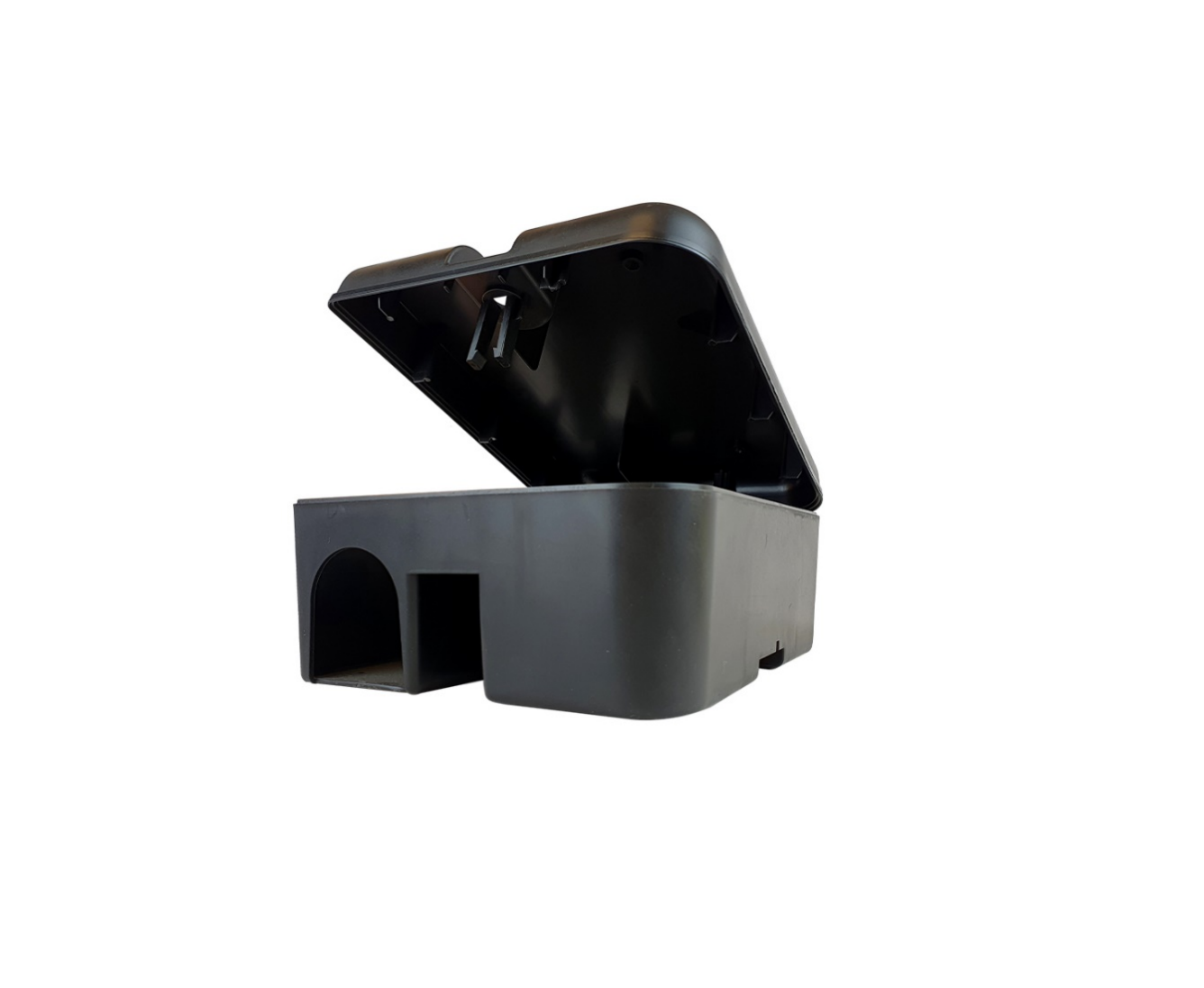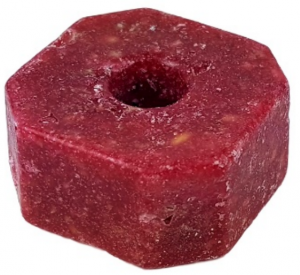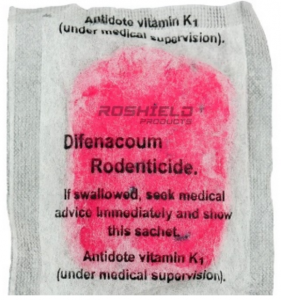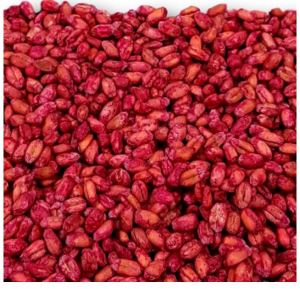Roshield Rodenticide & Trap Box Kit
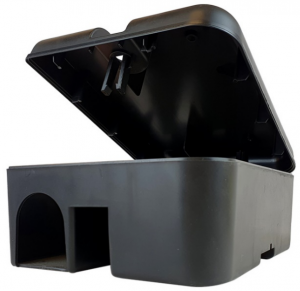
Roshield Rodenticide & Trap Box Kits
The Roshield box has been designed to enable the safe application of rodenticides and traps within areas of rodent activity whilst preventing non-target animals from gaining access. The lockable tamper-resistant design complies with the new regulations on the safe use of rodenticides and enables the safe placement of rodent control devices in both internal and external environments.
These instructions will vary depending on the kit purchased and certain accessories may not be included, if in doubt please refer to the listing from where the purchase was made. Not all kits include rodenticide and/or a trap.
It is unlikely that non-rodent species will enter the box but in order to minimize this risk further it is recommended that the box is placed in a discreet location such as behind or under a shed. Using additional materials, such as branches, to cover the box will also help reduce the risk of accidental entry by non-target animals and interference from people.
Prior to placing the box, a survey of the treatment area should be undertaken in order to identify any risks that may need to be controlled. During the survey it is important to identify and remove any current food sources that the rodents have access to. One of the main reasons for treatment failure when dealing with rats and house mice is due to not removing the initial food source.Where this food source remains, there is little appeal for the rodent to search out new food sources.
Opening the Box & Inside the Box

The cross headed key is needed to open the box. |
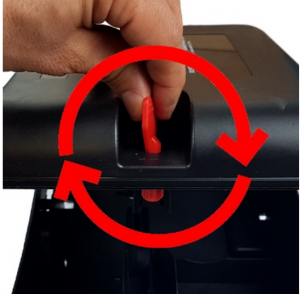
Insert the supplied key fully into the top hole and twist the key 45’ (clockwise or anti-clockwise) whist pulling the lid up and away from the base. |

Inside the box is an open area between the 2 entrance points. This area should be left empty to allow rats and mice to enter freely. |
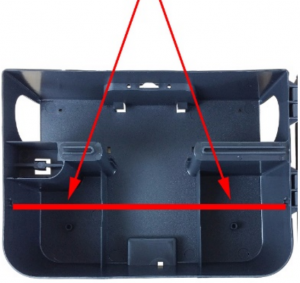
At the back is a rear chamber where the bait rod is securely held. |
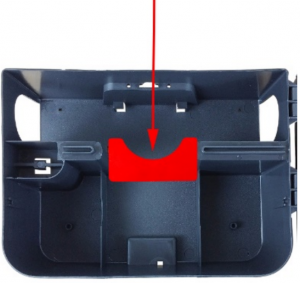
An additional bait divider can be placed between the front entrance and rear chamber to prevent spillage and to hold additional loose bait. |
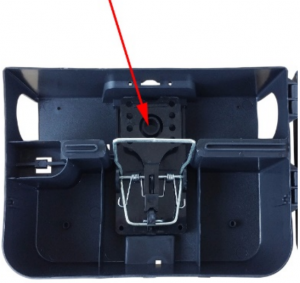
The central section has been designed for holding rat traps. |
Baiting the Box with Rodenticide
Roshield have three formulations of rodenticide bait available within the UK and EU; blocks, wheat and pasta.
Before undertaking any treatment using rodenticide, it is important that you read and comply with the instructions on the rear of the packaging.
As best practice the bait rod (included with kits containing rodenticide) should be used to help prevent rodents from dragging rodenticide outside of the box which may lead to non-target animals consuming the bait. The rod also prevents rodents, especially rats, from removing bait from the box and storing it which prevents other rodents from gaining access to the bait.
|
Blocks |
Roshield blocks are designed with a hole through the center which allows the block to be easily threaded onto the bait rod within the rear chamber of the box.Roshield recommend inserting 5-7 blocks on to the rod.Rest the rod on the side grooves. |
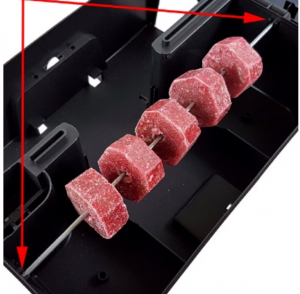 |
|
Pasta |
Roshield pasta is manufactured as soft material, the bait rod can simply be inserted directly through the sachet.The individual sachets should be removed from the outer packaging. Removing the internal paper sleeve is not necessary, rats and house mice will simply chew directly through this.Roshield recommend inserting 7-10 sachets on the rod. |
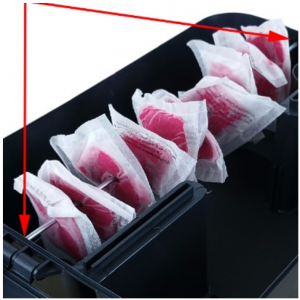 |
|
Wheat |
Recent changes in regulations has resulted in additional safety precautions being necessary when using granular rodenticides such as wheat.The wheat packet (maximum 150g) should be placed directly into the box. The included bait rod can be used to pierce directly through the center of the bag to help reduce spillage. Alternatively, the lid can be used to clamp the top part of the bag to prevent movement. The rodents will chew through the packetIf you are using professional bait the wheat can be dispensed into the side chambers at the rear of the box. An additional bait divider can also help prevent spillage as well as hold additional bait for larger infestations. |
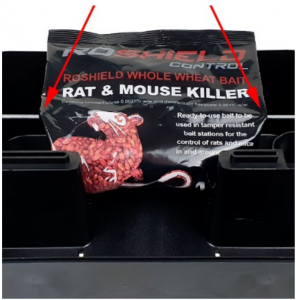 |
Once the bait has been installed close the lid securely. The box is now ready to place carefully and securely into the area of rodent activity.
Roshield boxes should be positioned near to burrows or areas in which the rats are actively feeding, do not place boxes in open areas as rats are more cautious when in the open and are less likely to enter the box. Try not to place them directly onto a run, just to the side increases the likelihood of rats entering.
It may take several days before the rodents enter the boxes as rodents can be cautious towards unfamiliar items placed in their territory. This is a common issue and not a sign of a defective product.
The amount of bait required to control an infestation will vary. However, it is important to continue baiting until all activity ceases as under-baiting can cause treatments to fail.
Large quantities of bait consumption by rats is not unexpected and can be a sign of a larger than expected infestation.
Activity may increase after a treatment as the rodents can become slow after consuming bait so this means the likelihood of spotting the rodent is higher. This is a typical sign of the rodenticide working. It is important that rodent carcasses are removed to prevent other animals eating these dead rodents.
When the bait is no longer being taken and it appears that the infestation has been eradicated it is important to remove the contents of the box and store safely.
Once the treatment has been successful it is recommended that additional steps such as proofing are undertaken as this will help to prevent the problem from re-occurring.
A comprehensive rodenticide instruction sheet is available at: www.roshield.co.uk/downloads.
Using the Box with Traps
The Roshield box has been designed to hold a range of traps for the control of rats and house mice including the professional quality Roshield rat trap.
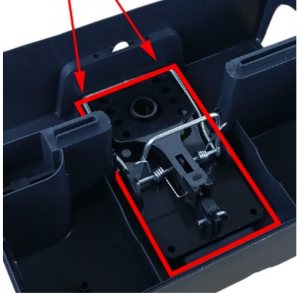 |
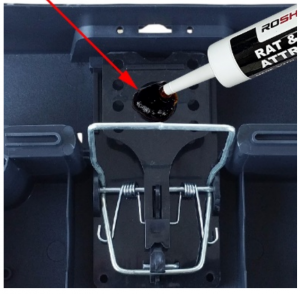 |
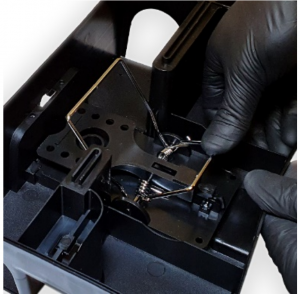 |
|
Insert the trap into the box with the trigger mechanism facing the fixing holes. The box has a fitting plate to which the Roshield traps fit snugly into. |
Bait the trap with an appropriate attractant within the central bait cup.A small amount of the same bait can be added at the entrance of the box and on any active rat runs as this can encourage the rat to explore the area and quickly find the box. |
Place a thumb on the top metal bar and push down, keeping fingers clear of the active area Push the bar all the way to the base until the bar clicks into place. The trap is now set. |
The type of bait that will work will vary and this can be trial and error. Roshield bait attractant is recommended. However, chocolate spread or a crunchy peanut butter can be a suitable alternative. It is a good idea to match the bait to food that the rodents would normally be feeding from.
As an optional feature a cable tie can be fitted to the top rear bar of the Roshield trap. The cable tie is a useful way of setting the trap and enables easy monitoring without opening the lid. To install, push the cable tie through the rear lower exit hole before closing the box and then pull on the tie to set the trap.
Place the box near to burrows or areas that the rats are actively feeding. Do not place them in open areas as rats are more cautious when in the open and less likely to enter the box. Try not to place the box directly onto a run.
It is important to remove any food or water that rodents may have access to. This will entice them to look for alternative sources and will quicken the trapping process. When controlling rats around chickens particular care may be needed to prevent food from leaving trays, etc.
It may take several days before the rodents enter the box as rodents can be cautious to new items placed in their territory. This is a common issue and not a sign of a defective trap or box.
It is important to check the traps daily and remove the carcasses to avoid trap shyness. When the trap is no longer catching and the infestation appears to have been eradicated the trap should be removed. It is prudent to leave the box in situ for a period of time so that should retreatment be needed rodents will enter the box more readily.
A comprehensive trap instruction sheet is available at: www.roshield.co.uk/downloads
After the Treatment
Once control of the population has been achieved steps should be taken to prevent reoccurrence. Proofing of entry points is a common tool used to help prevent reoccurrence and some common proofing examples are given below:
- Mice can gain access through a hole of approximately 5mm in diameter.
- Install wire wool or mesh to entrance gaps and pipe work in both internal and external locations.
- Bristle strips should be installed to door bases.
- Mesh guards should be fitted to ventilation bricks.
- Caps should be placed on the top of drainpipes to prevent rats accessing the pipes.
- Broken drains must be repaired where rats have used these to access building cavities.
- Cutting back ivy and other climbing plants to below soffit level will remove a common access path.
Cleaning of Infected Areas
Internal areas where rodents have been active may become contaminated and pose a risk of transmission of bacteria and viruses associated with rodents. By using an appropriate cleaning biocide spray such as the Roshield Sanitizer & Cleaner Spray or Roshield Anti-Bacterial Sanitizer Aerosol these can be removed and the risk reduced.
Always wear personal protective equipment including an appropriate mask when cleaning in confined spaces or untreated environments.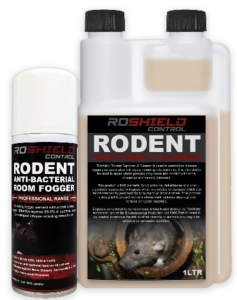
Technical Issues
Rodenticide:
- If the rodents are not entering the boxes after a number of days, but still active within the area, consider moving the box to an alternative location, away from open areas and preferably as close to feeding areas or nesting sites.
- If the rodents continue to ignore the box then the placement of a non toxic food source on the run near to and at the entrance of the box will help entice the rodents to explore and switch food sources.
- If rodents are still not showing an interest in the box, it is likely that they have an alternative food source, and this should be investigated further and removed.
- If the rodents are entering the box freely but they are not taking the bait then Roshield recommend either using a different formulation of bait (block to pasta or grain) or pre-baiting the box with a non-toxic food to gain trust with the rodent.
Traps:
- If the box has been ignored for a number of days, consider moving the trap to a new location.
- A common problem is bait being taken and the trap mechanism not going off. This could be a rodent being extremely cautious but it’s likely that the rat will soon be bolder enough to trust the trap. Before re-baiting test the trap mechanism with a soft object to check that the trap is working OK.
- Another issue can be slugs and snails eating the bait. Check the box and remove any slugs / snails before adding a light sprinkle of salt to the floor of the box to prevent further activity.
- If rats are still not showing an interest it is likely that the rats have an alternative food source and this should be investigated further and removed.
© Text & Images Copyright Fort Products Limited
[xyz-ips snippet=”download-snippet”]

